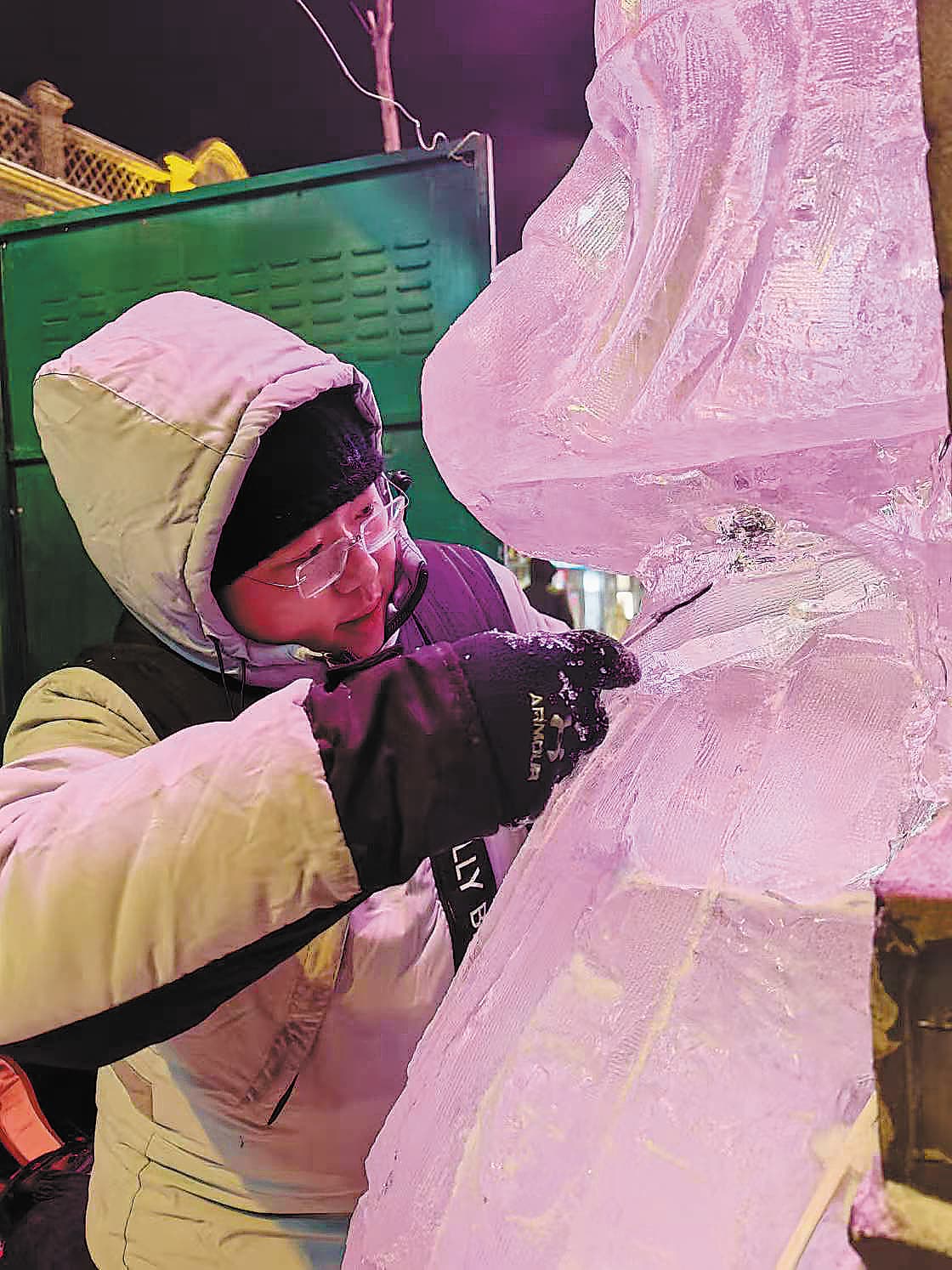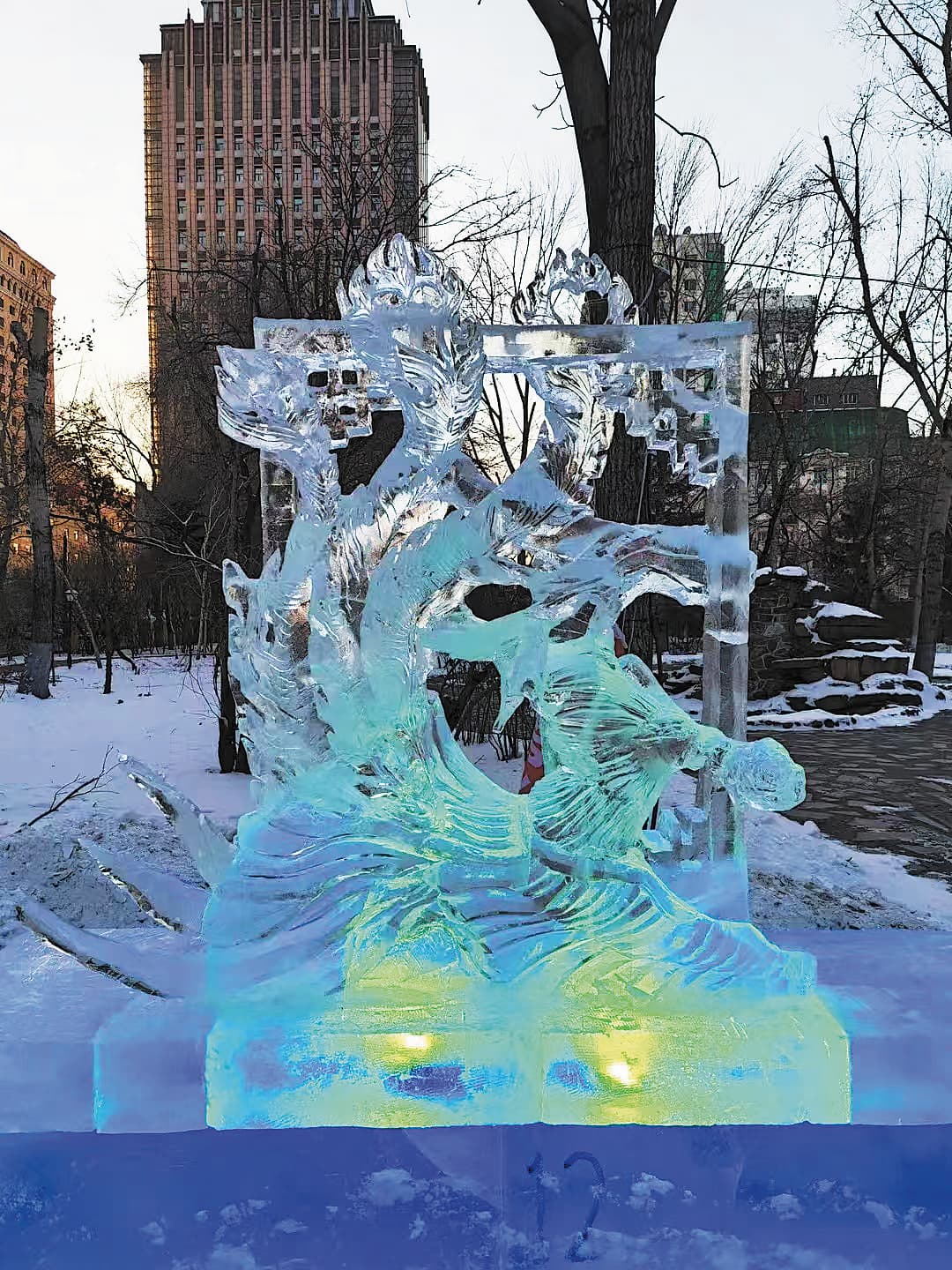
Xu Haonan carefully carves one of the ice sculptures that will decorate Harbin, Heilongjiang province. PHOTO PROVIDED TO CHINA DAILY
In the bitter chill of winter, a group of ice sculptors in Harbin, Heilongjiang province, chisel and carve plain blocks of ice into exquisite works of art.
One of those sculptors, Xu Haonan, has spent eight years practicing ice sculpture, an art form he has been involved with since his childhood.
"The first ice lantern I ever saw was made by my grandfather. I witnessed the process of him freezing a few pieces of colored paper in a small bucket and tying it to a wooden stick with a rope," said Xu, who was born in 1998.
"During the Lantern Festival when I was six years old, I really wanted to buy a lantern like every other child, but the financial situation of my family wouldn't allow for it," he said.
"That's why my grandfather managed to freeze an ice lantern for me using a water bucket," he said. "I loved it so much, and I still remember its appearance."
Xu lived near the Songhua River, and often saw workers collecting ice blocks from the frozen watercourse in the winter.
"At that time, I was curious, and imagined that, one day, I could create such works," he said. "So I chose public art as my major when I entered Harbin University in 2016. I also participated in various ice sculpture competitions, winning several national and international medals."
After graduation in 2020, Xu tried different jobs, such as art teacher and designer.
"At every interview, I would ask the company whether I could have three months away every winter to work on ice sculptures in Harbin," he said. "So, I missed out on a lot of good jobs."
In December 2023, Xu established his studio, focusing on ice carvings and, in early 2024, he became design director at a creative cultural company in Beihai, Guangxi Zhuang autonomous region.
"The process of ice carving is not easy," he said. "From design, material selection and carving, to the final polishing, each step requires a significant amount of time and effort."
"Especially in the cold, working outdoors for long periods is a great test of an ice sculptor's physical strength and willpower," he added.
The ice sculptures in Harbin are all hewn from natural raw materials.
On the frozen Songhua River, which runs through Harbin, workers near the riverbank use a chain saw to cut blocks to the required size.
"After receiving the ice blocks, carving usually begins around 7 am. I often work outdoors for 10 hours a day, but I enjoy every single minute."
Xu and his team are renowned for creating exquisite, small sculptures.
"We do not aim for the grand impact of large ice sculptures, but rather focus on the refined details of the works, such as the textures," he said. "Sometimes, the sculpting process becomes part of the attraction for tourists to observe."
"Furthermore, ice sculptures in Harbin keep up with the times. Instead of being limited to traditional subjects, such as the 12 animals of the Chinese Zodiac, they embrace popular IPs, or more modern subjects. Ice sculptors work based on current trends, seeking a blend of tradition and modernity, technology and future changes."

A sculpture by Xu's team lights up as night falls. PHOTO PROVIDED TO CHINA DAILY
Due to long hours working in the cold, many ice sculptors develop bad backs and shoulders.
"Although I'm only 26 years old, I suffer from severe lumbar disc herniation," he said.
"As older generations of ice sculptors gradually retire due to age and for health reasons, the ice carving industry is facing a shortage of talent."
"There are about 10,000 people in Harbin engaged in the ice carving industry, including ice and snow architects, but less than 1,000 people are proficient in ice carving techniques."
"I hope more young people will come to understand and appreciate ice carving, and be willing to join the industry," he added.
With the continuous development of the ice and snow economy in the country, tourism in Harbin is booming.
"While I was in Guangxi, my customers were excited to hear that I could create ice sculptures, and eagerly listened to my explanations about ice carving and the customs of Harbin," he said.
So far, Xu has created over 100 ice sculptures.
"This winter, Harbin is still eagerly anticipating the arrival of tourists, especially with the upcoming Asian Winter Games," he said. "Our ice carving orders have increased by around 20 percent compared to previous years."
"I hope to create more beautiful ice sculptures to provide visitors with even more wonderful visual experiences," he said. "I also hope to contribute to the healthy development and inheritance of the ice carving industry."
ZHOU HUIYING and TIAN XUEFEI in Harbin